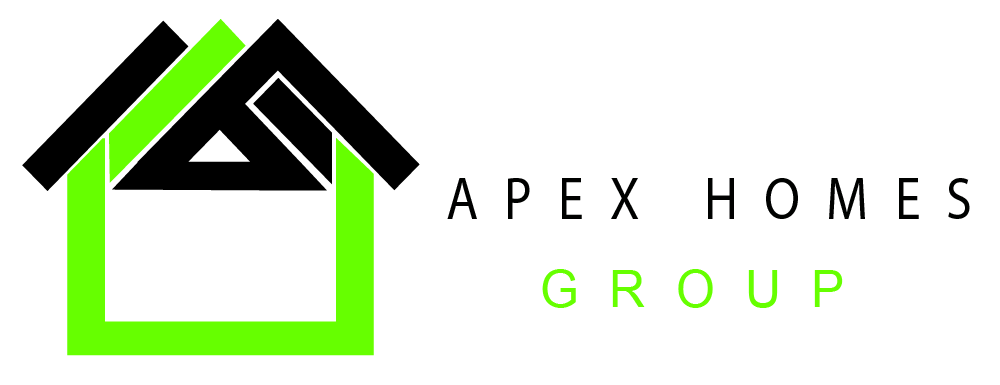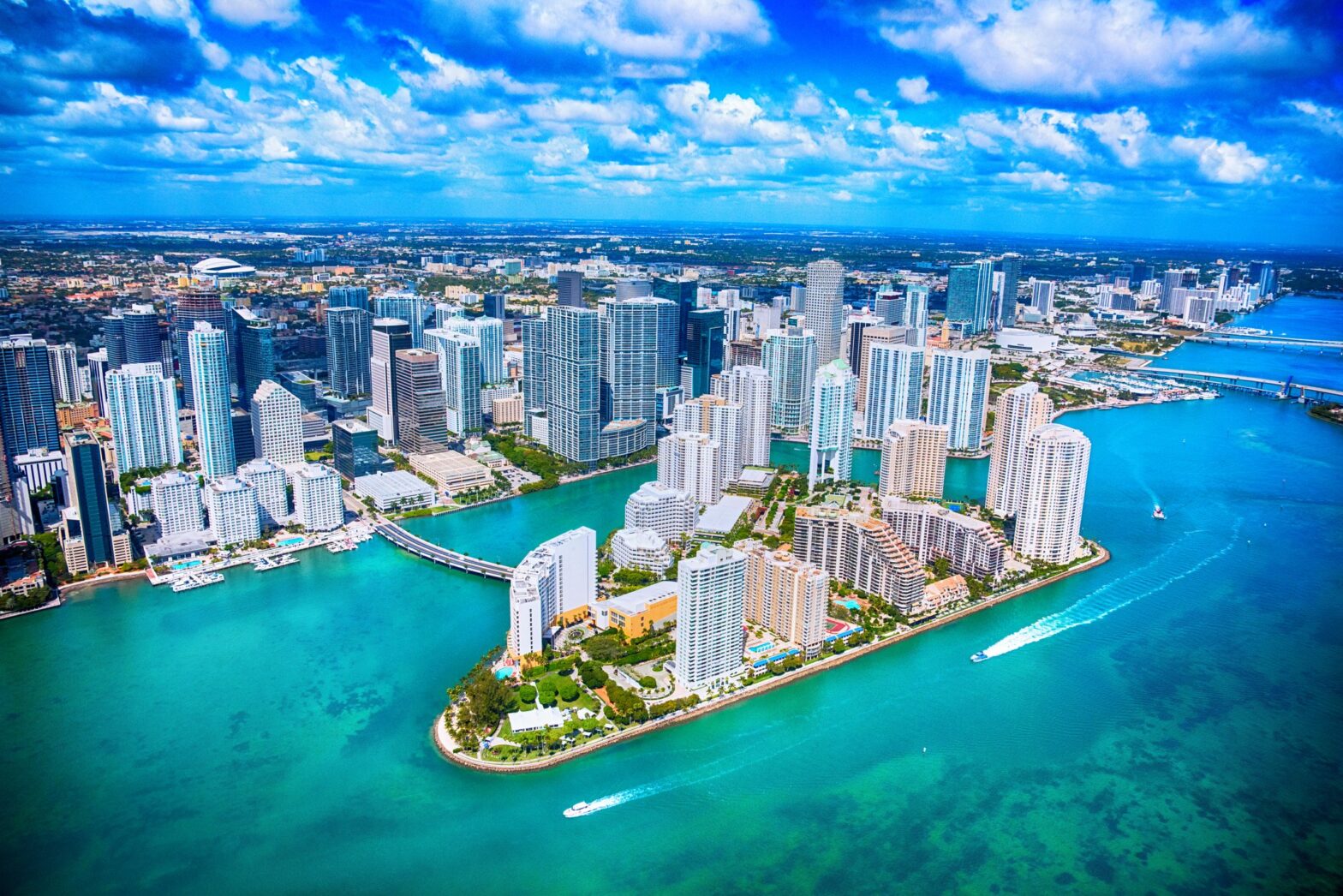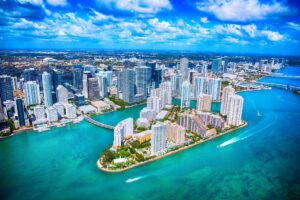
The housing market in South Florida is soaring, with single-family homes sales increasing by over 24% and median sales prices growing by nearly 18% compared to one year ago. New residents and business relocations from high-tax urban areas like New York are driving the demand for real estate in South Florida.
While rising home prices may be bad news for many homebuyers, it’s music to the ears of rental property investors, helping to explain why rental growth and the demand for rental property is so strong in South Florida.
South Florida is the southernmost part of the state and is home to about 100 cities and towns including Miami, Fort Lauderdale, West Palm Beach, Boca Raton, Boynton Beach, and North Miami.
Also known as the Greater Miami Area, South Florida is the 7th-largest metropolitan area in the U.S. and the 2nd-largest in the southeastern U.S., right behind the Washington-Arlington-Alexandria MSA. The region spans across more than 6,000 square miles and three counties – Miami-Dade, Broward, and Palm Beach – and is home to more than 6.7 million residents.
The job market, growing population, and quality of life help make the region golden for national and international business, locals and immigrants, and real estate investors seeking predictable cash flows and long-term appreciation.
Population Growth
Florida’s population is expected to increase by almost 26 million people by 2030, with South Florida leading the way, according to the Florida Chamber of Commerce. The influx of foreign-born residents along with people and businesses migrating from high-tax urban areas are playing a key role in the population growth of South Florida.
Key Population Stats:
- Population of South Florida is 6.2 million.
- The South Florida region is projected to increase by more than 12% for each of the next three decades.
- South Florida’s population is projected to reach 6.9 million in the next ten years, and 7.6 million by 2045, based on research by the University of Florida.
- Over the last four years, population growth rates in South Florida have begun slowing, averaging about 0.6% for the three-county region.
- Net population gains in South Florida are driven by foreign-born residents immigrating to the U.S., as reported by the Miami Herald.
- In fact, the region welcomes nearly as many new immigrants as New York City, with more than 87.2% of all foreign-born residents in South Florida coming from Latin America.
Job Market

As the 12th-largest economy in the U.S., the economic output of South Florida is about the same as Hong Kong, Israel, Colombia, and Chile. In fact, the 120 miles along Miami-Dade, Broward, and Palm Beach counties in South Florida are often thought of as Florida’s Gold Coast because of the thriving amount of international trade and domestic commerce.
Key Employment Stats:
- GDP of South Florida is over $377 billion and has grown by more than 59% over the last ten years.
- Non-farm employment is more than 2.7 million, with nearly 70,000 new jobs added year-over-year, based on a report from the Business Development Board of Palm Beach County (BDB).
- Over the next seven years the job market in South Florida is projected to grow by 7.5%, according to the Florida Department of Economic Security.
- Unemployment rate in South Florida is lower than other major metro areas such as Boston, New York, and San Francisco, as reported by the BLS.
- Business sectors in South Florida showing the lowest rates of unemployment include education, health services, and professional business services.
- Industries with the highest job growth projections over the next seven years include construction, retail trade, transportation, leisure and hospitality, and financial services.
- South Florida is the 2nd-largest international banking center in the U.S., according to Florida Trend.
- More than 1,400 multinational corporations and 75 foreign consulates and trade centers are based in South Florida.
- South Florida is home to the domestic and international divisions of Spanish-language broadcasters Univision Communications, NBC Universal Telemundo, and HBO Latin America.
- High-profile companies located in the South Florida region include German grocer Aldi, Ecolab, Chiquita Brands International, Sixt rent a car, and Hong Kong-based Techtronic Industries (maker of brands such as Milwaukee Tool, Ryobi, Hoover, and Oreck).
- South Florida companies that plan on expanding include aviation/aerospace firm Cyient Defense Services in Jupiter, FL; Fluorotek in Riviera Beach, engineering and tech company Levatas in West Palm Beach, physician staffing firm Hayes Locums in Fort Lauderdale, Kellstrom Aerospace in Miramar, financial consulting firm Slalom in Miami, and aerospace giant Bombardier in the City of Opa-Locka.
- Major public and private colleges and universities in South Florida include University of Miami, Florida International University, Miami Dade College, University of Fort Lauderdale, and Palm Beach State College.
- On average, 86% of the residents have a high school education or higher, and nearly 32% hold a bachelor’s or advanced degree.
- Interstate highways in South Florida include I-95, I-75, and I-395.
- PortMiami, Port Everglades, Port of Palm Beach, and Miami River Port are the four seaports in South Florida serving cargo and commercial cruise lines.
- Miami International Airport, Fort Lauderdale – Hollywood International Airport, and Palm Beach International Airport in South Florida provide service to nearly 90 million domestic and international passengers each year.
Real Estate Market
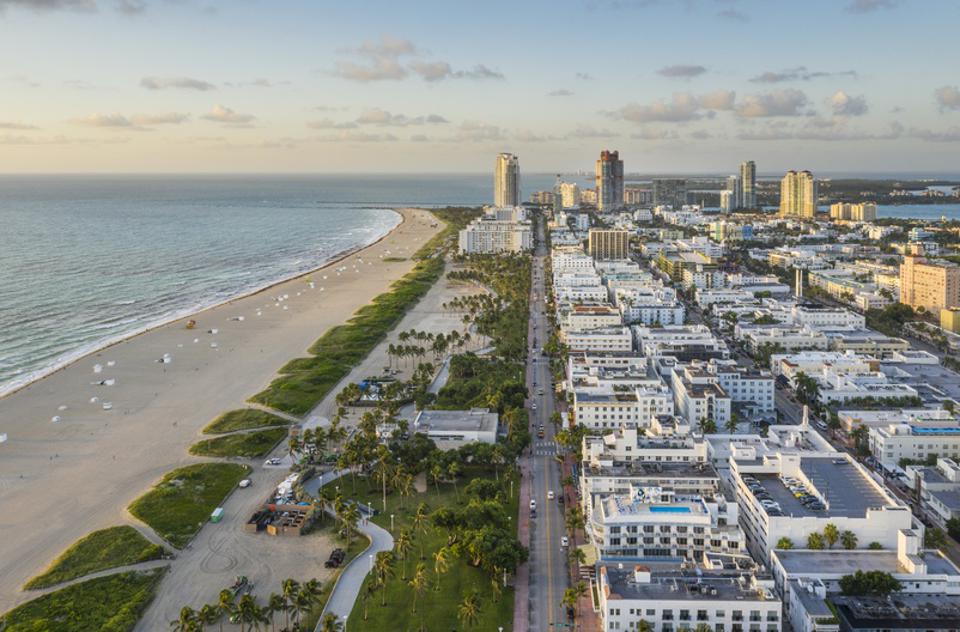
Single-family home sales in South Florida’s housing market are soaring. According to the South Florida Business Journal, sales volume and prices have grown by double digits with sales of single-family homes increasing by 24.4% compared to the same month a year ago.
Key Market Stats:
For the three-county South Florida region of Miami-Dade, Broward, and Palm Beach counties according to Realtor.com (as of November 2020) and the most recent information from Zillow.
Miami-Dade County
- Biggest cities: Miami, Hialeah, Homestead
- Zillow Home Value Index: $331,925
- Annual home value increase: 4.6%
- Projected annual increase: 7.5%
- Median listing price: $395,000
- Median selling price: $355,000
- Median list price per square foot: $286 per square foot
- Days on market (median): 82
- Sale-to-list ratio: 96.95%
- Of the 78 cities in Miami-Dade County, Gables By The Sea is the most expensive with a median listing price of $1.2 million while Kendale Lakes is the most affordable city with a median listing price of $290,000
Broward County
- Biggest cities: Fort Lauderdale, Pompano Beach, Hollywood
- Zillow Home Value Index: $290,960
- Annual home value increase: 5.9%
- Projected annual increase: 7.6%
- Median listing price: $337,000
- Median selling price: $335,000
- Median list price per square foot: $220 per square foot
- Days on market (median): 7689
- Sales-to-list price ratio: 97.5%
- Of the 40 cities in Broward County, Parkland is the most expensive with a median listing price of $749,000 and Lauderhill is the most affordable city with a median listing price of $160,000
Palm Beach County
- Biggest cities: Boca Raton, Boynton Beach, West Palm Beach, Palm Beach Garden
- Zillow Home Value Index: $306,751
- Annual home value increase: 6.1%
- Projected annual increase: 8.2%
- Median listing price: $349,000
- Median selling price: $330,000
- Median list price per square foot: $204 per square foot
- Days on market (median): 74
- Sales-to-list ratio: 96.84%
- Of the 64 cities in Palm Beach County, the City of Palm Beach is the most expensive with a median listing price of $1.7 million while West Delay is the most affordable city with a median listing price of $186,300
Attractive Renters’ Market
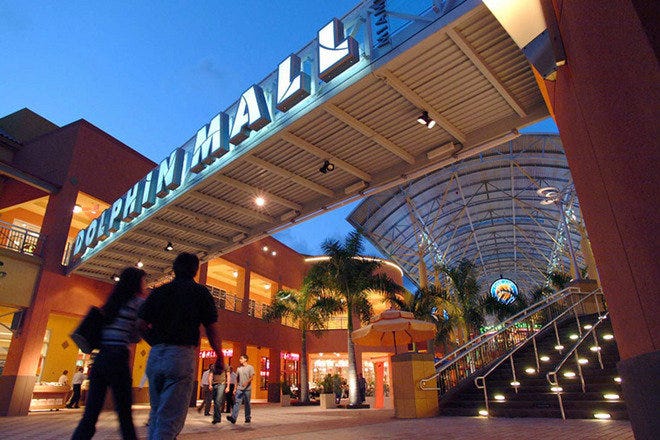
The housing market in South Florida has been booming for much of 2020, with single-family homes “spinning on and off the market at a fast pace,” according to the South Florida Sun Sentinel.
Although the market is strong, remote real estate investors looking for rental property may be able to find some good deals. According to the newspaper article, some sellers are offering credits and price discounts for property that needs renovations.
Some of the hottest rental markets for tenants renting by necessity in South Florida include Oakland Park, Deerfield Beach, Tamarac, and East Fort Lauderdale.
Key Market Stats:
For the three-county South Florida region according to RENTCafé for Miami, Fort Lauderdale, and Palm Beach County (as of October 2020).
Miami-Dade County (Miami)
- Average rent: $1,679 per month
- Annual rent increase: -2%
- Percentage of renter households: 45%
- Rent range: 74% of units have rents ranging from $1,001 to $2,000 per month
Broward County (Fort Lauderdale)
- Average rent: $1,944 per month
- Annual rent increase: -1%
- Percentage of renter households: 50%
- Rent range: 92% of units have rents ranging from $1,000 or higher per month
Palm Beach County
- Average rent: $5,561 per month
- Annual rent increase: 20%
- Percentage of renter households: 44%
- Rent range: 89% of units have rents ranging higher than $2,000 per month
Historic Price Changes & Housing Affordability
Analyzing the historic change in home prices and affordability are two techniques that real estate investors can use to help forecast the demand for rental property. Two readily-available resources for housing data are the Freddie Mac House Price Index (FMHPI) and Kiplinger’s housing affordability report.
Based on data from Freddie’s most recent FMHPI report, these are the historic changes in home prices for South Florida:
Miami-Fort Lauderdale-West Palm Beach MSA
- October 2015 HPI: 196.50
- October 2020 HPI: 275.57
- 5-year change in home prices: 40.2%
- 1-year change in home prices: 9.4%
- Monthly change in home prices: 1.5%
The housing affordability report from Kiplinger compares median home prices with the median income needed to purchase a home.
Kiplinger ranks the top 100 metropolitan areas on an affordability index scale of 1 to 10, where 1 represents the most affordable markets and 10 represents the least affordable housing markets in the U.S.
The firm’s analysis of housing affordability in the Greater Miami Area reports:
- Since the last real estate cycle market peak in May 2006, home prices in the Greater Miami Area declined by 17.1%.
- Since the last real estate cycle market bottom in March 2012, home prices in the Greater Miami Area have increased by 103.4%.
- Greater Miami has an affordability index of 8 out of 10, meaning that the market is one of the least affordable places in the U.S. to buy a home.
Quality of Life
Several neighborhoods in Miami, Fort Lauderdale, and West Palm Beach were recently listed among South Florida’s best neighborhoods to live by the South Florida Business Journal. The report examined 15,000 towns and neighborhoods and compared key quality-of-life factors such as cost of living, job opportunities, public schools, and crime statistics.

Key Quality of Life Stats:
- South Florida is the only major region in the continental U.S. with a tropical climate.
- Less than a four-hour drive to world-class Orlando-area theme parks such as Disney, SeaWorld, and Universal Studios Florida, and Epcot.
- PGA of America rates the Blue Monster at Doral and Heron Creek Golf Club as two of the best golf courses in South Florida.
- Best beaches in South Florida include South Beach, Pompano Beach, and the Florida Keys.
- Cleveland Clinic Florida, Baptist Hospital of Miami, and University of Miami Hospital and Clinics – UHealth Tower are three of the top hospitals in South Florida, according to U.S. News & World Report.
- Pro sports teams in South Florida include the Miami Dolphins, Miami Marlins, and Miami Heat.
Source: https://learn.roofstock.com/blog/south-florida-real-estate-market
